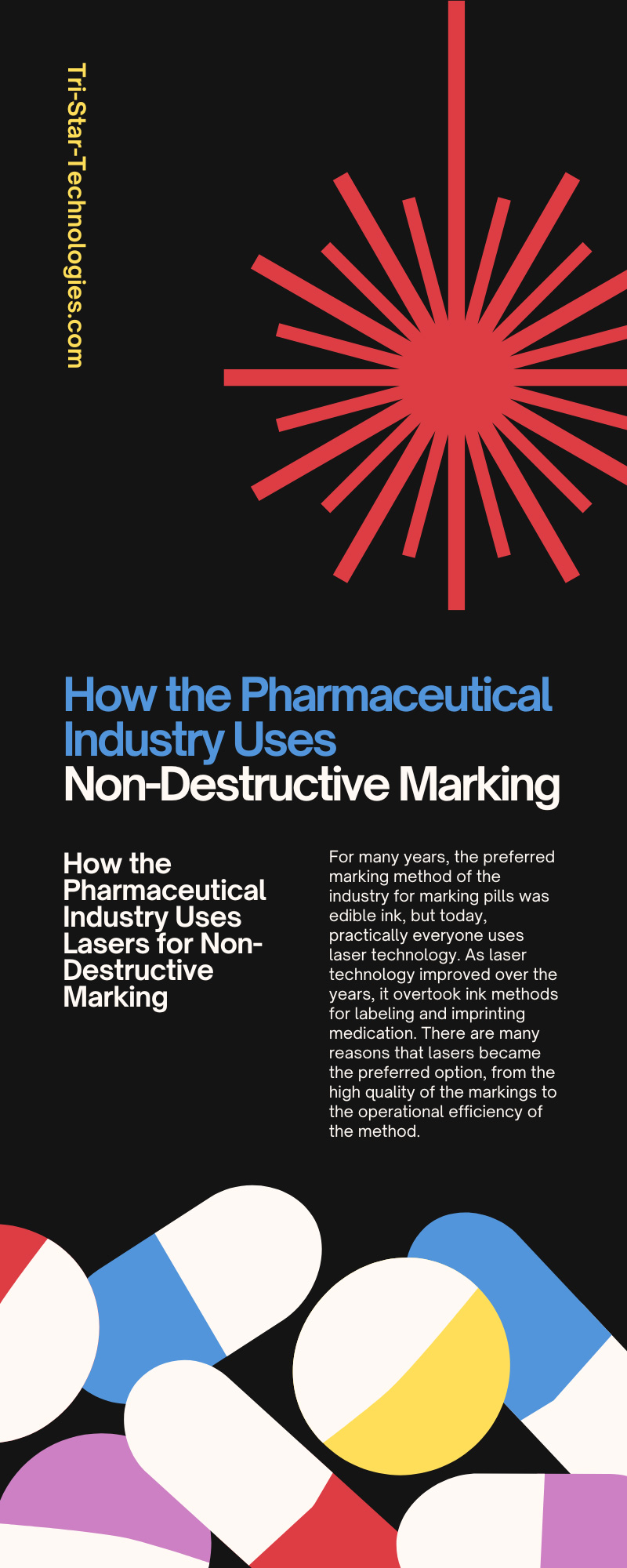How the Pharmaceutical Industry Uses Non-Destructive Marking

Non-destructive marking is an essential technology used by the pharmaceutical industry today. Keep reading to learn why this technology is integral to the pharmaceutical industry and how it’s done.
WHY THE PHARMACEUTICAL INDUSTRY NEEDS PILL MARKINGS
What’s the point of marking pills and tablets for pharmaceutical companies in the first place? To start, it’s the law—the Food and Drug Administration (FDA) requires all medication sold in the US to have a pharmaceutical imprint code.
Why does the FDA enforce this rule? There are many reasons, but the primary benefits are that it avoids confusion for patients and pharmacists, helps to identify counterfeit and illegal drugs, and ensures accountability for drug manufacturers.
Avoid Confusion
One of the most practical benefits of clear, identifiable markings on pills and tablets is that it helps people avoid confusing one medication for another. Any patient who must take multiple doses of various medications daily knows the challenge it can be to keep track of them all. This is especially true for older patients, who are the ones who most commonly have to consume such medication.
We all drop or mix up our pills or tablets at one point. The markings on the medication help doctors, pharmacists, and regular patients quickly identify and distinguish medication without trouble. While most pills have varying sizes, shapes, and colors, the markings are the surest way to guarantee their identification.
Identify Counterfeit & Illegal Drugs
Another advantage of FDA-approved markings on all drugs is that it helps patients and authorities identify counterfeit and illicit drugs. If a pill or tablet doesn’t have a pharmaceutical imprint code or has an incorrect code not recorded in the FDA’s index, it could be a fake or illegal drug.
Unfortunately, counterfeit drugs are a problem in the pharmaceutical industry, but these clear markings help catch many fraudsters and prevent patients from consuming potentially dangerous fake medication. Many illegal recreational drugs can look like FDA-certified medication, so having a clear code to distinguish the two makes drug enforcement much easier. If you find a pill or tablet in your medication without a marking, report it to the relevant FDA authorities.
Pro Tip: An oral medication without a marking could also be from a foreign country, as not every country requires imprint codes for drugs manufactured within their borders.
Ensure Accountability
Another reason that the FDA requires these identification codes for all pills and tablets is it ensures accountability. With the pharmaceutical imprint code, every pill or tablet manufactured in the US is marked and accounted for. Just by looking up the code, the FDA can identify the manufacturer and other relevant information, like the medication’s strength.
If a batch of medication is tainted or contaminated, the authorities can identify the pill itself and its manufacturer so that the source of the problem can be exposed quickly. Pill markings are one of the industry’s most important tools for keeping companies accountable and exposing illegal activity.
WHAT THE MARKS ON PHARMACEUTICAL PILLS & TABLETS MEAN
The markings on pills and tablets don’t seem to mean anything to the regular person, but that’s by design. The markings on medication can be practically anything, like a brand’s corporate logo, a special symbol, or simply a series of numbers or letters.
What is imprinted on the pill or tablet isn’t so important—what’s crucial is that the imprint is identifiable and unique. Once the FDA catalogs the mark for that medication, there will be a record of what pill that marking is for, who manufactures the pill, its strength, and more relevant information. Every pill has its unique marking, so there’s no confusion.
HOW THE PHARMACEUTICAL INDUSTRY USES LASERS FOR NON-DESTRUCTIVE MARKING
So how do companies imprint these elaborate and distinct designs and codes so clearly onto such a small surface? The pharmaceutical industry uses what’s called non-destructive marking with lasers.
For many years, the preferred marking method of the industry for marking pills was edible ink, but today, practically everyone uses laser technology. As laser technology improved over the years, it overtook ink methods for labeling and imprinting medication. There are many reasons that lasers became the preferred option, from the high quality of the markings to the operational efficiency of the method.
THE BENEFITS OF USING LASER TECHNOLOGY FOR PILL MARKING
Safe & Sanitary
There are many reasons why laser technology overtook inkjet and other marking methods, but the main reason is that it’s a much safer and more sanitary method. In the pharmaceutical industry, sanitation is critically important to ensuring the safety of medication and patients—even regarding marks and labels.
Since laser pill marking does not require any physical materials to contact the pill or tablet, there’s less risk of contamination. Older methods were sanitary, too, but medication is always cleaner and safer if it doesn’t contact other materials.
High-Quality, Tamper-Proof Marks
Another reason lasers became the preferred method is they produce high-quality, distinctive, and tamper-proof marks. Whether using UV or green lasers, the cold laser marking process produces clear and definitive marks that won’t fade, smear, or be tampered with as ink labels can be.
While ink labels are often fine for markings, they can be quite easily replicated, adjusted, or have misprinting problems. On the other hand, laser marks are much more reliable and durable.
Fewer Operational Costs
When we think of lasers, we think they’re incredibly expensive and require so much maintenance, but they’re the more cost-efficient method. Laser marking technology has progressed to the point where there’s not much equipment or maintenance, and it requires few supplementary costs, unlike ink.
Anyone who has tried to fix a printer filled with ink knows how costly, expensive, and messy it can be!
Flexibility
Lasers are also much easier to adjust and modify when needed. With ink and other methods, adjusting the stamping and printing process can require much time and effort to make even the smallest changes.
Laser markings, on the other hand, can quickly and efficiently adjust the shape, color, and even size of the mark with little difficulty. The quick adjustment capability means less downtime, more productivity, and more laser marking efficiency.
CONCLUSION
We hope our guide on the pharmaceutical industry and laser marking has been informative and helpful in understanding why this technology is so crucial to the industry. If you’d like to learn more about the laser technology used in the pharmaceutical industry, contact the expert staff at Tri-Star Technologies.



